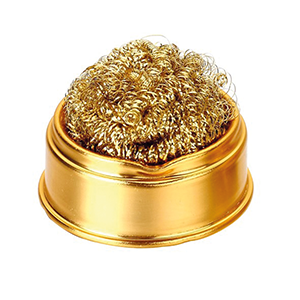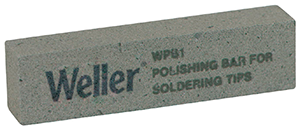
The tip of a soldering iron is one of the most critical parts of the tool, as failure to perform its function of effective heat transfer to the connection being soldered will result in a poor connection and ultimately, a failure of the electronic circuit. Poor tip maintenance is one of the leading causes of problematic soldering performance.
Soldering tips do wear out over time and eventually will need replacing, but taking steps to care for the iron tip can extend its life, save money and improve the results of soldering work.
High-quality solder
One of the most effective preventative measures that can be taken to protect solder tips is the use of high-quality solder. When low-quality solder that contains impurities is used, those contaminants may build up on the tip, thereby decreasing heat transfer and making soldering work more difficult.
Solder quality can be easily tested by heating it and observing how easily it melts. Good-quality solder should melt readily at the expected temperature, while low-quality solder may not melt completely. Most 60/40 (tin/lead) solder should melt easily at 238°C.
If solder contains lead, the appearance will also give an idea of its quality as melted lead solder will appear shiny, while a low-quality product will look more matte. In contrast, high-quality melted lead-free solder has a matte appearance.
Choosing the right type of solder for your project is vital. The required composition depends on the material that you are planning to solder and whether flux is being used, as well as health and safety concerns. The US Safe Water Drinking Act, for instance, requires the use of lead-free solder on all lines that will carry drinking water.
The amount of solder used is also a critical factor as excess solder can end up in a socket or base which may lead to short circuits or jammed switches.
Maintaining optimal temperature
Keeping the temperature of a soldering tip as consistent and as close to optimal as possible will help extend its life.
When using many soldering irons, the temperature of the tip will naturally dip when in use. To compensate for this, many technicians increase the heat setting more than is required for the solder being used. Using excessive temperatures, however, reduces the life of tips and can result in sub-optimal results.
Soldering station irons with a built-in high-quality temperature sensor help to regulate temperature without damaging tips. These irons can sense when the temperature has moved out of the set range and provide automatic adjustment.
Excessive temperature of the iron impacts the life span of the tip so using temperatures that are higher than needed should be avoided. This principle also applies when the iron is not being actively used; if left on for an extended period while not in use, the iron’s temperature should be reduced to an ‘idle’ setting, which occurs automatically on certain soldering stations.
Weller soldering irons offer excellent temperature stability. The WEP70 iron of the Weller WE 1010, for example, has a temperature stability of ±6°C. It also has a standby mode and auto setback feature that reduces the temperature of the iron when idle.

Cleaning of tips
Keeping a soldering tip clean is crucial to ensuring proper performance and extending its life. Tips should be cleaned before, during and after use.
Before soldering, alcohol and a clean cloth may be used to remove contaminants such as grease, corrosion and oxidation from the surface of the material to be soldered. To clean tips, either brass or stainless steel wool may be used. Brass wool is more common, as it is softer and less abrasive but does not last as long as the harder stainless steel wool.
Metal wool effectively removes dirt and other contaminants and avoids issues associated with using a damp sponge to clean soldering tips. Frequent wiping on a damp sponge causes repeated changes in the temperature of the tip, causing it to expand and contract repeatedly. This cycle causes metal fatigue and eventually leads to failure of the tip.

After cleaning with metal wool, the tip should be immediately tinned with fresh solder to prevent oxidation. For heavier-duty cleaning, a Weller WPB1 cold-tip polishing bar may be occasionally used. However, this should be done sparingly and only when the tip is cold, as using it with a hot tip can damage the tip.
If a tip does become oxidised, it should be flushed several times with a rosin-activated, flux-cored solder. This process should remove the oxides, unless excessive oxidation has built up. After cleaning, the tip surface must be covered with a thick coating of solder.
Using flux
In several metals, an oxide layer is formed when they come into contact with oxygen in the air. This layer of oxidation prevents solder from adequately wetting the joint, and negatively impacts the quality of the solder joint.
Flux is a substance that removes this oxidation layer. The flux dissolves the metal oxide layer, which evaporates once the flux reaches its boiling point. Flux may come in paste form, or it may be in the core of a soldering wire, which allows it to work as you are soldering the part with no extra effort.
Dipping tips into flux to clean them must be avoided, as the substance is corrosive and some fluxes, called water-soluble fluxes, can damage tips at higher temperatures. Many processes use these fluxes when doing projects that require wave soldering, immediately followed by a full cleaning to remove excess flux residue on the circuit board. Using wire solder and water-soluble flux for touch-up and rework operations will still hasten tip failure.
Another type of flux called no-clean flux is only for soldering parts that require little to no cleaning. This very mild cleaning action normally isn’t thorough enough to remove oxidisation from soldering iron tips, and a badly oxidised tip will be easy to spot because of ‘burnout,’ which is the appearance of black or brown coating.
Tinning soldering tips
Tinning a tip covers the tip in a thin layer of solder, thereby protecting it from oxidation by creating a protective layer between the air and the iron. Oxidation prevents the tip from transferring heat efficiently.
Tips should be tinned before and after each soldering session, as well as in between soldering every two to three joints. The tip should always be kept tinned from first use until it is discarded.
Keeping tips tinned also helps ease the soldering process. A tinned tip helps solder wire melt and flow better, and the coating creates a heat bridge between the tip and the part being soldered, which increases the efficiency of the heat transfer.
Throughout a soldering project, the tip should be cleaned and re-tinned after every few joints. Once the project is completed, the tip must be wiped clean after tinning, before the iron is turned off.
Reactivating tips
If a tip becomes oxidised, it will appear dark, and may not be able to be tinned properly. This problem may be fixed by using a tip activator to reactivate or re-wet it.
To reactivate the tip, it is dipped into the paste-like activator substance and moved around until it starts to become shiny again. The fine abrasives and additives within the activator will break down and remove the oxide layer.
Once the tip looks clean, it can be removed from the activator and cleaned using brass or steel wool before being re-tinned. Flushing the tip with solder by re-tinning it will remove any remaining contaminants.
Storing tips
The way soldering iron tips are stored can also impact how well they perform and how long they last. Following simple procedures when storing tips can help protect them.
When storing a tip for a shorter period, such as between soldering joints in one soldering session, place it in the iron in a secure iron holder. Ensure it does not stay at the operating temperature, as this will decrease the life of the tip. Many Weller irons can be stored at an idle setting, which keeps them at a lower temperature, but still ready to be used.
If storing tips for an extended period, they should be cleaned and tinned before storing, which will help prevent oxidation from occurring. Once cooled they may also be placed inside a sealed container to further protect them from oxidation, humidity and contamination.
When storing a tip in the iron, the nut or screw that holds it in place should be loosened before storage to prevent the tip from becoming stuck, an issue known as seizing.
| Tel: | +27 11 704 3020 |
| Email: | [email protected] |
| www: | www.ama-sa.co.za |
| Articles: | More information and articles about Allan McKinnon & Associates |

© Technews Publishing (Pty) Ltd | All Rights Reserved